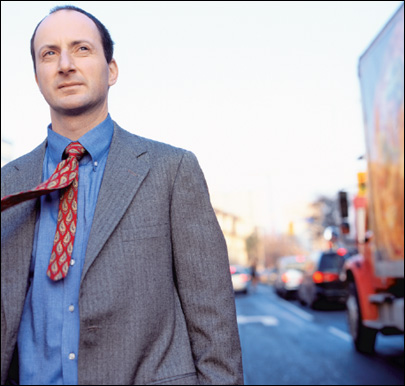
Matthew Turner is a 2012 PERC Julian Simon Fellow and professor of economics at the University of Toronto. His research focuses on the economics of land use and transportation. We thank Matthew for taking time to answer our questions. For more PERC Q&As, visit the series archive.
Q: At your latest PERC workshop you presented new research, co-authored with Victor Couture and Gilles Duranton, entitled “Speed.” What aspect of speed are you looking at and why is it important?
A: Bakeries in the Soviet Union used to hand out bread for free to the first in line while those at the back wait for the next batch. This was wasteful. It meant time was spent waiting that could otherwise be used for something else, and it gave bread to people with the most time on their hands rather than to the hungriest or the hardest working. We allocate highway space in much the same way. The commuter who arrives on the road at 7:00am gets to travel, but the one who arrives at 7:30am needs to waits in a traffic jam until road capacity becomes available. Just as for the old Soviet bakery, this leads to a lot of time wasted in traffic jams and assigns scarce rush-hour capacity to people willing to wait in traffic, who might not be the people who value rush hour travel most highly.
In our research we are try to understand the determinants of driving speed in order to estimate the value of time lost to waiting in traffic. Since road travel, one way or another, accounts for about 18% of gdp, the value of this waste is a big number. We also want to develop a basis for making guesses about what a good road pricing system would look like.
Q: You claim there are sizable welfare gains to be had from more sensible transportation policies? What sorts of policies are we talking about? Taxes on driving?
A: Our research suggests that the failure to price access to roads leads Americans to waste tens of billions of dollars worth of time each year sitting in traffic. Yet roads are congested only part of the time and even our biggest and busiest cities have unused road capacity off peak. If we impose tolls on congested roads at congested times, we give people an incentive to shift their travel to an uncongested time when we have surplus road capacity. This saves people from waiting in traffic and will likely increase the capacity of our road network.
Q: Are there areas where congestion pricing has worked? Could it be implemented on a wide scale in the United States?
A: Stockholm, London, and Singapore, and a handful of U.S. roads and bridges have congestion pricing programs. In these places we see big increases in travel speed in response to pretty small charges for peak hour road use. With that said, the devil is in the details. So far, these programs are expensive to administer and it is easy to imagine ways that they could create problems. Rather than aiming for wide scale application to the United States we ought to encourage pilot programs in congested cities like New York, Miami, Seattle, Boston and Portland. As we gain experience administering congestion pricing programs we can apply them more widely.
Q: In earlier research you find that widening and building more roads actually creates more traffic. What is “The Fundamental Law of Road Congestion” and what are its implications for transportation policy?
A: In this project we examine the relationship between the stock of highways and arterial roads in large U.S. cities and the total amount of road travel in these cities. More precisely, it examines the relationship between a city’s total lane kilometers of highway and arterial road and total miles driven within the city in a year. We find that a one percent increase in road lane kilometers causes almost exactly a one percent increase in driving. We also find that changes to the stock of buses in a city’s public transit network do not affect driving.
This means that we should not expect either road or transit expansions to alleviate traffic congestion in the long run. The only policy that we know to be effective at reducing traffic congestion is congestion pricing.
Q: When might investments in public transportation or road building be worthwhile?
A: Even though road and transit expansions probably won’t reduce congestion on our roads and highways, they will allow more people to move around. We want to evaluate transportation infrastructure on the basis of the value of these extra trips. If a new subway line allows an extra 50,000 people to work downtown, we need to decide if the extra economic activity downtown justifies the cost of the train. The same is true of road expansions. We don’t have good answers to this question yet. Generally, it looks like expansions of highway and subway capacity are so expensive that it is going to be difficult to pass this test, especially in the countryside where rural state senators like to send federal highway funding. On the other hand, making investments that squeeze more capacity out of existing roads and tracks in big cities is going to be easier to justify.
For more from Matthew Turner on transportation policy, read his article in the Fall 2010 edition of PERC Reports.



